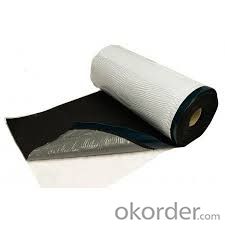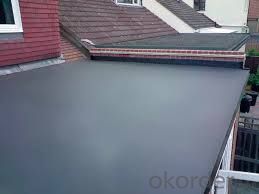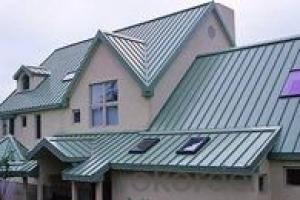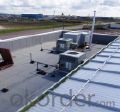SBS Bitumen Polyester Waterproofing Membrane
- Loading Port:
- Shanghai
- Payment Terms:
- TT OR LC
- Min Order Qty:
- 1000 m²
- Supply Capability:
- 200000 m²/month
OKorder Service Pledge
OKorder Financial Service
You Might Also Like
Product description
SBS Waterproof Material Self Adhesive Aluminium Membrane is produced with SBS elastomer and bitumen as raw materials, using polyethylene film.
Aluminium foil coated on the upward or no file(both side self-adhesive) while self-adhesive protection layer on the downward
surface.It has a widely prospect new contruction waterproof materials. Good self-adhesion, no leaking,cold flexibility,especially
in self-adhesion. That is unque product in waterproof and application.
Packaging & Shipping
| Packaging Details: | in bulk or standard export pallect package |
| Delivery Detail: | within 10 days after receiving the deposit |
.
Advantagee
1.1m or 2m width, we can produce as your requirment
2.Simple and Efficient Construct, Greatly Saving Construct Period
3.Advanced Production Line
4.Excellent Comprehensive Physical Properties
5.Stable Dimension
6.Wide Adaptability of Facing Material
7. Cold-applied construction with no open flame and self-adhesion without bonding agent make it safe, low- carbon, environmental, and economical.
8. Excellent adhesive performance guarantees the integrity of waterproof layer.
9. Good rubber elasticity, elongation and shear stress.
10. Good low-temperature property.
Application method
1) Widely used in the industrial and civil building roofing, underground, pool, tunnel, wooden and metal roofing.
2) Specially applied in the oil depot chemical factory, garment factory, and granary.
3) Especially used in cold places.
4) Tape used for sealing all construction material surfaces.
Our Services
1.If you need some advises for the waterproof construction, we have the best engineer to serve you.
2.We send the free samples to you by freight collect.
3.We will guarantee the quality and the competitive price.
4.We will give you the best packaging and safe shipping.
5.If any problem, we will always be right here waiting for you.
Storage:
Different types or specifications of products should be separated, not mixed.
Keep it dry and ventilated, protected from the sun or rain.
Storage temperature should never be higher than 45 °C. Pile up the membranes flatwise whose stockpile height never exceeds five layers. One layer is guaranteed if it is placed vertically.
Prevent it from inclination or In the process of transportation, it should be lying in case of inclination or lateral pressure. If necessary, cover it with felt-cloth.
Storage time is at least one year from manufacture date on if the product is under normal operation of storage.
Technical Parameters
Item | Index | ||||||
1 | Thickness of resin layer of the middle fabric ,mm≥ | - | - | 0.40 | 0.40 | 0.40 | |
2 | Tensile performance | Max tensile strength,N/cm ≥ | - | 120 | 250 | - | 120 |
Tensile strength,NPa ≥ | 10 | - | -10 | - | - | ||
Max elongation% ≥ | - | - | 15 | - | - | ||
Breaking elongation % ≥ | 200 | 150 | - | 200 | 100 | ||
3 | Heat treatment size change rate%≤ | 2.0 | 1.0 | 0.5 | 0.1 | 0.1 | |
4 | Cold bonding | -25°c No cracks | |||||
5 | Watertightness | 0.3mPa,2h waterproof | |||||
product show















FAQ
Q: What's the de6abf1fe186f8d58506cbcfe46eed814d.jpglivery time ?
A: 3-5 days for 1-600 rolls, 10-15 days for container.
Q: What's the payment terms ?
A: TT/LC
Q: How do you make replacement with quality problems ?
A: New replacement will be packed into your next order or send to you directly after receive video or photo about quality problems.
- Q: Can waterproofing membranes be applied in cold weather?
- Yes, waterproofing membranes can be applied in cold weather. However, it is important to consider a few factors when applying these membranes in low temperatures. Cold weather can affect the curing process of the membrane, potentially slowing it down. It is crucial to ensure that the surface being waterproofed is dry and free from ice or frost before applying the membrane. Additionally, some waterproofing products may have specific temperature requirements for optimal performance, so it is essential to consult the manufacturer's guidelines. In colder temperatures, it may also be necessary to use specialized adhesives or primers designed for cold weather applications. Overall, with proper precautions and the use of appropriate materials, waterproofing membranes can be successfully applied in cold weather.
- Q: Are waterproofing membranes resistant to jet fuel?
- Waterproofing membranes are typically designed to resist the penetration of water and other liquids. However, jet fuel is a highly volatile and corrosive substance that can pose a significant challenge to the effectiveness of waterproofing membranes. While some waterproofing membranes may provide a certain level of resistance to jet fuel, it is generally recommended to implement additional protective measures when dealing with such hazardous materials. To ensure the maximum resistance against jet fuel, it is advisable to use specialized membranes that are explicitly designed to withstand the corrosive effects of this substance. These specialized membranes are typically made from materials such as polyurethane or epoxy, which have proven to be more resistant to jet fuel compared to standard waterproofing materials. Moreover, it is important to consider the specific application and environmental conditions when determining the resistance of a waterproofing membrane to jet fuel. Factors such as temperature, exposure time, and concentration of the jet fuel can influence the membrane's performance. Regular inspections and maintenance should also be conducted to identify any signs of degradation or potential weaknesses in the membrane. In summary, while some waterproofing membranes may offer a certain level of resistance to jet fuel, it is crucial to use specialized membranes and implement additional protective measures to ensure optimal performance and protection against the corrosive effects of jet fuel.
- Q: Can a waterproofing membrane be used in residential buildings?
- Yes, a waterproofing membrane can indeed be used in residential buildings. In fact, it is highly recommended as it provides an effective barrier against moisture, preventing water damage and mold growth. Waterproofing membranes are commonly used in areas prone to water exposure such as basements, bathrooms, roofs, and balconies. They are typically applied on the exterior or interior surfaces, creating a protective layer that prevents water infiltration. This helps to maintain the structural integrity of the building, extend its lifespan, and enhance the overall comfort and safety of the residents. Therefore, using a waterproofing membrane in residential buildings is a wise investment to protect against potential water-related issues.
- Q: Can a waterproofing membrane be used in conjunction with soundproofing materials?
- Yes, a waterproofing membrane can be used in conjunction with soundproofing materials. In fact, it is quite common to use both of these materials together in construction projects. Waterproofing membranes are typically used to prevent the penetration of water into a structure, while soundproofing materials are used to reduce noise transmission. These two materials serve different purposes but can be used simultaneously to provide both waterproofing and soundproofing benefits. For example, in a building with a basement or a bathroom, a waterproofing membrane can be installed on the walls or floors to prevent water infiltration, and then soundproofing materials can be added on top of the membrane to reduce noise transmission from adjacent areas. By combining these two materials, a building can be protected from water damage while also providing a quieter and more comfortable environment for its occupants.
- Q: Can a waterproofing membrane be used for bridges?
- Yes, a waterproofing membrane can be used for bridges. Waterproofing membranes are commonly used in bridge construction to protect the bridge deck and structural elements from water penetration and moisture damage. The membrane forms a barrier against water and prevents corrosion of reinforcing steel, extending the lifespan of the bridge.
- Q: Can a waterproofing membrane be used for potable water tanks?
- Using a waterproofing membrane for potable water tanks is not recommended. Although a waterproofing membrane is effective in preventing water penetration and protecting surfaces from moisture damage, it is not suitable for guaranteeing the safety and purity of potable water. To ensure the safety of the water, materials specifically designed and approved for water storage, such as food-grade coatings or liners, should be used for potable water tanks. These materials are formulated to prevent any leaching or contamination of the water, thus ensuring its suitability for consumption. Hence, it is crucial to adhere to industry standards and regulations and utilize appropriate materials when constructing potable water tanks.
- Q: Can waterproofing membranes be used on underground tunnels?
- Underground tunnels can indeed utilize waterproofing membranes. These specialized membranes are crafted to create a barrier against water infiltration and are widely employed in various construction contexts, including subterranean structures like tunnels. Typically composed of materials such as bitumen, asphalt, or synthetic rubber, these membranes possess exceptional waterproofing capabilities. Once applied to the walls and floors of a tunnel, waterproofing membranes establish a protective layer that hinders water from permeating into the tunnel. This becomes particularly crucial in underground tunnels, as they are vulnerable to water intrusion from the surrounding soil or groundwater. By implementing waterproofing membranes, the integrity and longevity of the tunnel structure are preserved, minimizing the risk of water damage, corrosion, and deterioration. Moreover, waterproofing membranes yield additional advantages, such as resistance against chemical attacks, prevention of mold and mildew growth, and enhancement of overall tunnel insulation. These membranes can be employed either during the construction phase of the tunnel or as a retrofit solution for existing tunnels. It is essential to note that the choice of the appropriate waterproofing membrane should be based on factors such as the tunnel type, anticipated water pressure, and overall design requirements. Seeking guidance from a professional engineer or waterproofing specialist is highly recommended to ensure the selection and installation of the most suitable waterproofing membrane for underground tunnels.
- Q: Can a waterproofing membrane be used on tunnels with vehicular traffic?
- Yes, a waterproofing membrane can be used on tunnels with vehicular traffic. Waterproofing membranes are designed to provide a barrier against water infiltration, protecting the structure from potential damage caused by moisture. In tunnels with vehicular traffic, water can seep through the concrete and cause corrosion, deterioration, and even compromise the structural integrity of the tunnel. By applying a waterproofing membrane, it creates a protective layer that prevents water from penetrating the tunnel walls, roof, and floor. This helps to extend the lifespan of the tunnel and ensures the safety of vehicles passing through. However, it is essential to select a waterproofing membrane specifically designed for heavy traffic conditions to withstand the constant load and wear. Additionally, proper installation and regular maintenance are crucial to ensure the effectiveness and longevity of the waterproofing system in tunnels with vehicular traffic.
- Q: What is the difference between pressure-sensitive self-adhesive waterproofing membrane and sbs asphalt waterproofing membrane?
- 2, from the construction method (1) pressure-sensitive self-adhesive waterproof membrane is the use of wet shop method, that is, the base surface and the membrane should engage in cement slurry, and finally, the shop on it. And sbs asphalt waterproofing membrane using the roasted method, quite troublesome. So from the construction method, the two differences are relatively large, the former construction more convenient.
- Q: Can a waterproofing membrane be used for stadiums and sports arenas?
- A waterproofing membrane is suitable for stadiums and sports arenas, as they are subjected to different weather conditions and are susceptible to water damage. These large structures can be effectively protected against water infiltration by applying waterproofing membranes to various areas such as the roof, walls, and foundation. This not only maintains the building's integrity and extends its lifespan but also prevents expensive repairs caused by water damage. Moreover, these membranes offer insulation and energy-saving advantages, thereby improving the overall performance of the stadium or sports arena.
Send your message to us
SBS Bitumen Polyester Waterproofing Membrane
- Loading Port:
- Shanghai
- Payment Terms:
- TT OR LC
- Min Order Qty:
- 1000 m²
- Supply Capability:
- 200000 m²/month
OKorder Service Pledge
OKorder Financial Service
Similar products
Hot products
Hot Searches
Related keywords
































